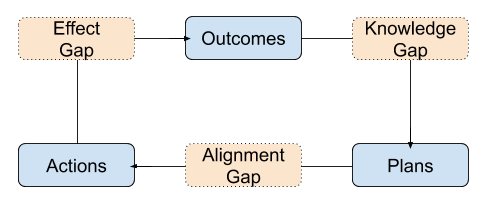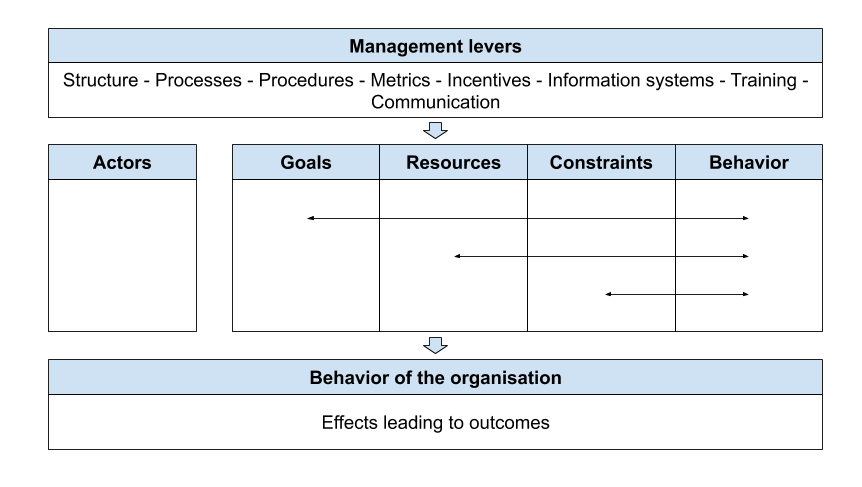 The Art of Action: How Leaders Close the Gaps between Plans, Actions and Results by Stephen Bungay
The Art of Action: How Leaders Close the Gaps between Plans, Actions and Results by Stephen Bungay
My rating: 4 of 5 stars

Knowledge Gap – Caused by the chaotic world in which we live in and how it changes.
Alignment Gap – Caused by miss alignment between top-level and low-level managers.
Effect Gap – The difference between the result achieved and the result desired
Real uncertainties produce psychological uncertainties which we do not like. As such we try to over come these gaps in the following ways:
Classic Knowledge Gap solution– Get more information and more analysis than resolution and action. This in tern slows things down and means the data is more out of date which can itself increase the risk which the data was supposed to help with.
Classic Alignment Gap solution – Forcing top managers to specify exactly what they want people to do – stressing actions rather than outcomes, causing extra work and confusion. People don’t feel trusted so push decisions up the organisation, which causes frustration and a reinforcing loop.
Classic Effect Gap solution – Causes extra controls to “ensure” they get what they wanted. Metrics, typically on inputs rather than outputs, are put in place and monitored. This adds additional cost and bureaucracy. Creating a culture of risk avoidance, checks and close supervision making the problem worse.
These are the result of the separation of strategy and execution. Here managers produce the strategy and workers execute it. This separation produces a rigidity meaning that as the situation changes the plans can not be followed.
The book presents an alternative approach whereby everyone is deciding on strategy in align with the higher intent and execution. This approach is termed “Directed opportunism”. A key element of this is to provide both alignment and autonomy.
Alignment and Autonomy – These can be seen as opposite ends of a spectrum, however you can still have Autonomy with Alignment. “Directed opportunism” is seen as a way to achieve this. A key element of this approach are carefully constructed commands, consisting of the following components:
- Context – What is the situation?
- Higher Intents – Firstly, the what and why from my boss; Secondly, the what and why of their boss.
- My Intent – What are we trying to achieve and why?
- Measures – In order to know if the intent is being realised – however care must be taken that the measures themselves are not the target. Metrics along with other observations should all be taken into account.
- Implied Tasks – Main Tasks, responsibilities and timing. Highlight which is the main effort.
- Boundaries – What are our freedoms and what are the constraints
- Backbrief – Has the situation changed? No – the brief is valid; Yes – we have to change some tasks, but what we are trying to achieve is still valid; Yes – and we have to change what we are trying to achieve
Directed opportunism Knowledge Gap – Limit direction to defining and communicating the intent
Directed opportunism Alignment Gap – Allow each level to define how they will achieve the intent of the next level up and “backbrief” so that there is a closed loop to ensure understanding.
Directed opportunism Effect Gap – Give individuals freedom to adjust their actions in line with intent
A key element is that for this to work means that the people doing this need to be competent and suitably skilled.
At a time there is a key intent – a sequence of these are built such that there is clarity on what must be achieved to move towards the ultimate goal.
A briefing cascade will only work properly if the organisational structure broadly reflects the task structure. If it is in conflict it should be change before anything else. It requires an appropriate level of hierarchy of entities that can be made wholly or largely accountable for critical tasks, led by people who are skilled and experiences enough to make autonomous decisions.
People tend to act rationally based from their point of view


Typically strategy includes plans, incentives, targets, work-plans etc being passed to the day to day bussiness to operate. Instead the book uses a three tier approach with strategy, execution and tactics.
Leadership and management are not the only two approaches – directing is also an approach which should be in the tool box.
- Directing – authority, responsibility and duty of direction
- Developing strategy
- Giving direction
- Building the organisation
- Leading – Getting people to achieve objectives
- Task
- Team
- Individual
- Management – Organise and controlling resources to achieve objectives
- Resourcing
- Organising
- Controlling
In summary –
- We are finite beings with limited knowledge and independent wills
- The bussiness environment is unpredictable and uncertain, so we should expect the unexpected and should not plan beyond the circumstances we can foresee
- Within the constraints of our limited knowledge we should strive to identify the essentials of a situation and make choices about what it is most important to achieve
- To allow people to take effective action, we must make sure they understand what they are to achieve and why
- They should then explain what they are going to do as a result, define the implied tasks, and check back with us
- They should then assign the tasks they have defined to individuals who are accountable for achieving them, and specify boundaries within which they are free to act
- Everyone must have the skills and resources to do what is needed and the space to take independent decisions and actions when the unexpected occurs, as it will
- As the situation changes, everyone should be expected to adapt their actions according to their best judgement in order to achieve the intended outcomes
- People will only show the level of initiative required if they believe that the organisation will support them
- What has not been made simply cannot be made clear and what is not clear will not get done